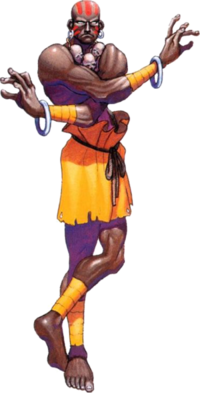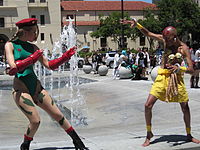- Dhalsim
-
Dhalsim 
Dhalsim in Super Street Fighter II. Drawn by Bengus.Series Street Fighter series First game Street Fighter II Voiced by (English) Don Carey (Street Fighter II: The Animated Movie)
Steven Blum (Street Fighter II V, Animaze)
Gary Chalk (Street Fighter animated series)
Christopher Bevins (Street Fighter IV)Voiced by (Japanese) Yoshiharu Yamada (Street Fighter Zero series)
Eiji Yano (SNK vs. Capcom: SVC Chaos)
Shōzō Iizuka (Street Fighter II V)
Daisuke Egawa (Street Fighter IV)
Yukimasa Kishino (Street Fighter II: The Animated Movie)
Rokurō Naya (Japanese television dub of the Street Fighter film)
Toshihiko Kojima (Japanese video and DVD dub of the Street Fighter film)
Daisuke Egawa (Street Fighter IV)Portrayed by Roshan Seth (Street Fighter film) Fictional profile Birthplace India Nationality Indian Fighting style (Mysteries of the Yoga (ヨガの奥義 Yoga no Ōgi)) Dhalsim (ダルシム Darushimu, based on Malayalam ധല്സിം)[citation needed], is a video game character from the Street Fighter series of fighting games.
Dhalsim made his debut in the original Street Fighter II as one of the game's original eight main characters. In his backstory, Dhalsim is characterized as a pacifist who goes against his beliefs by entering the World Warrior tournament to raise money for his village. In his ending, Dhalsim wins the tournament and returns home on his elephant Kodal. Three years later, Dhalsim's son, Datta, discovers a photograph of his father from the tournament.
From the original Street Fighter II and up until Super Street Fighter II, this ending graphics was drawn in a comical style. In Super Street Fighter II Turbo, it was changed to a more realistic style, with Dhalsim's wife and son - Sari and Datta, respectively - added to it.
Dhalsim would later appear in the Street Fighter Alpha sub-series in Street Fighter Alpha 2 and Street Fighter Alpha 3. In his storyline in the Alpha games (which are set prior to the events of Street Fighter II), Dhalsim attempts to hunt down an "evil spirit" (M. Bison) threatening the world.
Dhalsim also appears in the Street Fighter EX sub-series, beginning with the console-exclusive version, Street Fighter EX Plus Alpha, followed by Street Fighter EX2 and Street Fighter EX3. His characterization and motivation are the same as they are in the previous Street Fighter game.
Dhalsim is back in Street Fighter IV along with the rest of the original World Warriors.[1]
Dhalsim has also appeared as playable characters in several crossover fighting games, which includes X-Men vs. Street Fighter, Marvel Super Heroes vs. Street Fighter, Marvel vs. Capcom 2, Capcom vs. SNK, Capcom vs. SNK 2 and SNK vs. Capcom: SVC Chaos.
Contents
Character design
Dhalsim is often depicted as having pupil-less eyes. His build is that of a normal man who exercises and weight trains regularly except for his abdomen and waist which appear much out of proportion and emaciated. He wears torn saffron shorts as his only clothing attire as well as saffron wristbands and anklebands. He has three colored stripes adorning his head, and in the Street Fighter Alpha series, he wears a turban, that he removes before battle. In his origin, fighting style and special powers, Dhalsim resembles the hired Indian fighter in the 1976 Chinese wuxia film Master of the Flying Guillotine - a likely inspiration for Dhalsim.
His fighting style is a Yoga-based style, in which Dhalsim can stretch his arms, legs, abdomen and even his neck to great lengths making him a decent long-range hand-to-hand fighter. He also uses many fire-based attacks such as Yoga Fire, Yoga Flame and Yoga Blast, the latter being an anti-air technique. His super move in the Street Fighter EX, Cross Over and later Alpha Series was the Yoga Inferno, which was basically a multi-hitting flamethrower-style attack that could be directed manually.
Dhalsim also uses a teleportation technique known as the Yoga Teleport (M. Bison would later gain this ability in Street Fighter Alpha: Warriors Dreams). In Street Fighter EX3, he gains a tag-team super move when paired with Blanka. In Street Fighter IV he gains the ultra combo move "Yoga Catastrophe", which is a move similar to "Yoga Inferno" but he blows out a large fireball instead, which slowly moves towards the opponent and deals multi-damage on impact.
Cultural impact
In other media
Cosplayers portraying Cammy and Dhalsim from Street Fighter, at FanimeCon 2010 in San Jose, California.
In the Street Fighter II V, the UDON comic book series, and Street Fighter II: The Animated Movie, Dhalsim is a wise and powerful mystic who has mastered the inner mysteries of Yoga. In the comic, he helps prepare Sagat for his bout with Ryu and helps Ryu himself discover the darkness within his soul. Later on he is given an invitation to M. Bison's "Street Fighter II" global fighting tournament, wherein he defeats Adon in the preliminaries with ease.
In Street Fighter II V, Dhalsim is a monk who lives in a remote village in India. Sagat had earlier instructed Ryu to seek Dhalsim for advice about the Ways of Hadou. Sagat had been turned down years before when he sought Dhalsim's wisdom, but had figured that Ryu might be found more worthy. Dhalsim is a practitioner of yoga and has some psychic abilities, and although he knows much about Hadou, he was unable to train Ryu to use the Hadouken, which was inadvertently triggered in Ryu's body during a lesson. Dhalsim is voiced by Shōzō Iizuka in the Japanese version and Steve Blum in the English dub.
Dhalsim has a brief appearance in Street Fighter II: The Animated Movie, voiced by Yukimasa Kishino in the Japanese version and Don Carey in the English dub. Here he fights E. Honda in India but the match is withdrawn when Dhalsim cannot fight because he feels another power among us.
Dhalsim was portrayed by Roshan Seth in 1994's live action film Street Fighter. In the movie, Dhalsim was changed from a fighter to a meek doctor working on a "supersoldier" experiment for Bison. His science was originally supposed to promote peace but Bison corrupted it to serve perversion instead. In the end, (after he is burned and altered to look more like the character in the game) he decided to remain in Shadaloo alongside with Blanka (his creation), with last words of "If good men do nothing, that is evil enough." Dhalsim is later featured in the Street Fighter animated series as part of Guile's team.
From the original roster of Street Fighter II characters featured in the film, Dhalsim and T. Hawk are the only ones who do not appear as playable characters in the video game based on the film, Street Fighter. A viceversa situation occurs with Akuma, who is a secret character in the game but does not appear in the film. In November 2009 Lupe Fiasco's mixtape "Enemy of the state: A love story" included a remix of the Lil Wayne's "Fireman" titled "Yoga Flame" Fiasco states "I call this one Yoga Flame" and the first verse talks about the character Dhalsim and his fighting style and levitation ability. A sound bit from the original street fighter using his trade mark "Yoga Flame" is heard twice in the song.
Critical reception
In the February 1992 issue of Gamest magazine in Japan, Dhalsim ranked at No. 5 in the list of Best Characters of 1991.[2] IGN ranked Dhalsim at number eight in their "Top 25 Street Fighter Characters" article, noting his unique gameplay and role as a "popular oddball".[3] He additionally placed number fourteen on GameDaily's "Top 20 Street Fighter Characters of All Time" article.[4] He was also included in their list of the top 25 "baldies" by GameDaily.[5]
Topless Robot named him one of the most "Most Ridiculously Stereotyped Fighting Game Characters", calling him the most outlandish of Street Fighter II's cast and drew comparisons to the Indian assassin in the film Master of the Flying Guillotine.[6] The satirical book A Practical Guide To Racism, implicitly criticizes his portrayal as a sum of negative stereotypes of South Asians, where Hindus are portrayed as "nonviolent, magical, fastidious, stretchy, and pugnacious".[7]
The book Game Design Perspectives notes Dhalsim as an example of a "nemesis character" in video games, one difficult to master proper usage of but widely considered one of the strongest characters in the game as well.[8]
References
- ^ Street Fighter IV Unveiled news from 1UP.com
- ^ "第5回ゲーメスト大賞" (in Japanese). GAMEST (68): 4. http://www.netlaputa.ne.jp/~dummy/gamest/magazine/gamest/v068.html.
- ^ Top 25 Street Fighter Characters - Day IV. IGN. Retrieved on 2008-08-15
- ^ Top 20 Street Fighter Characters of All Time. GameDaily. Retrieved on 2008-11-12
- ^ http://www.gamedaily.com/articles/galleries/top-25-baldies/?page=23
- ^ Ciolek, Todd; Rob Bricken (2008-04-30). "The 10 Most Ridiculously Stereotyped Fighting Game Characters". Topless Robot. The Village Voice. http://www.toplessrobot.com/2008/04/the_10_most_ridiculously_stereotyped_fighting_game.php. Retrieved 2010-03-11.
- ^ Dalton, C. H. (2007). A Practical Guide to Racism. Gotham. pp. 61–62. ISBN 1592403484.
- ^ Laramée, Franc̜ois Dominic (200w). Game Design Perspectives. Cengage Learning. p. 137. ISBN 1584500905.
Street Fighter characters Street Fighter series Related characters Categories:- Fictional characters introduced in 1991
- Fictional characters who can stretch themselves
- Fictional characters who can teleport
- Fictional telepaths
- Street Fighter characters
- Characters created by Akira Yasuda
- Male video game characters
- Fictional Indian people
- Yoga
Wikimedia Foundation. 2010.

